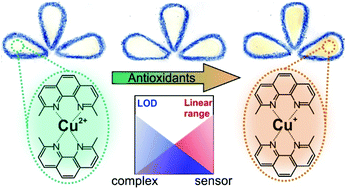Nanoclay-based sensor composites for the facile detection of molecular antioxidants†
Abstract
The detection and quantification of antioxidant molecules is an important task in food science, the fine chemical industry and healthcare. Antioxidants help in preventing the deterioration of nutrition and healthcare products, while eliminating over-the-limit exogenic reactive species, which may lead to illnesses. In our contribution, an inexpensive and rapid method to determine the concentration of various molecular antioxidants was developed. The principle of the analysis relies on the cupric ion reducing antioxidant capacity (CuPRAC) method, which is based on the color-changing reduction of chelated Cu2+ ions. This complex was successfully immobilized on an alginate-functionalized layered double hydroxide (dLDH) nanosheet via electrostatic interactions. The synthesis conditions of alginate (NaAlg) and the cupric complex were optimized, and the optimized composite was fabricated on cellulose paper to obtain a sensing platform. The paper-based sensor was superior to the ones prepared without the dLDH support, as the limit of detection (LOD) values decreased, and the linearity ranges broadened. The results offer a single-point measurement to evaluate the antioxidant efficiency in a cuvette-based method. The superior ability of the sensor was assigned to the presence of solid dLDH particles, as they offer adsorption sites for the dissolved antioxidant molecules, which contributes significantly to the decrease of the diffusion limitation during the detection process.



 Please wait while we load your content...
Please wait while we load your content...